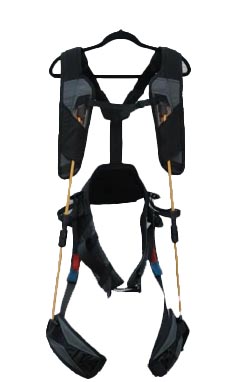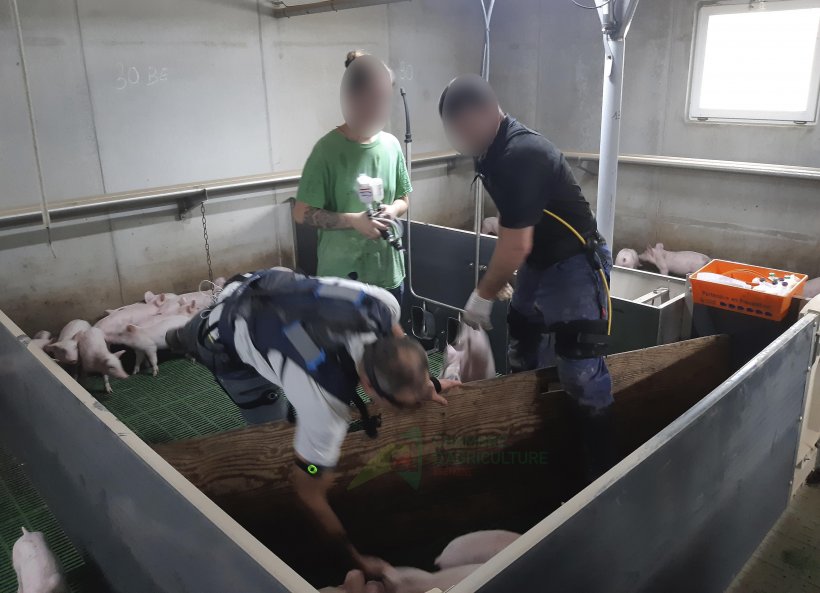In pig production, many farmers complain of back problems, which they attribute to their work. Tasks that require lifting numerous piglets in a short time, such as farrowing care or vaccinations, put a lot of strain on the back. There are solutions to avoid bending over, such as such as vaccination pits or piglet lifts. However, these solutions are rarely adopted for fear of losing time. Some farmers also prefer restraining piglets individually to ensure good vaccination quality.
Exoskeletons are devices a person can wear that provide physical assistance to perform a given movement (e.g. bending over, raising arms in a milking parlor, etc.). To assess their usefulness in improving working conditions during vaccinations, the MSA Armorique and the Brittany Chamber of Agriculture tested two models, with technical support from the consulting firm AGB Solutions.

The two models selected were passive (i.e., non-motorized) exoskeletons that provided assistance when the “torso is tilted more than 45°.” Both models were lightweight (approximately 1 kg). One model assisted via elastics on the back and the other via carbon rods on the front of the body.
Table 1. Comparison of the two exoskeletons used in the study.
| Model |  |
 |
| Support points | Shoulders Waist Upper thighs |
Shoulders Hips Above the knees |
| Exertion assistance system |
Crossed elastics in the back |
Carbon fibers from thighs to front of shoulders |
| Weight | 900 g | 1100 g |
*Photo credit for exoskeletons: Brittany Chamber of Agriculture.
Testing performed
In the first phase, tests were performed under controlled conditions, asking four people to lift 3, 6, 8, and 12-kg weights and perform specific movements. Each of the four people performed these series of movements three times, wearing, in a random order, one exoskeleton, the other exoskeleton, or no exoskeleton.
In the second phase, eight experienced farmers wore the same exoskeletons tested under controlled conditions but this time during piglet vaccination sessions. During the same session, the person involved in the test used, in a random order, one exoskeleton, the other exoskeleton, or no exoskeleton.
In both phases of the tests, different aspects of the working conditions were evaluated: task execution time, user perception (comfort, chafing, ease of use, etc.), cardiac activity, and the activity of six muscles: two in the back, two in the shoulders and two in the thighs. A medical examination was also performed beforehand to verify the absence of contraindications and to assess the pain level in 21 parts of the body.

Pig farmers testing the use of exoskeletons when vaccinating piglets. Source: Brittany Chamber of Agriculture.
Results
The tests under controlled conditions (with weights) showed a significant reduction in muscular effort in the back, between -4% and -19% depending on the muscle, the movement, and the exoskeleton model. This decrease was accompanied by a greater effort in the thigh muscles.
However, tests performed during vaccination showed a significant increase in back strain: +16% with one model and +37% with the other. Stress also increased significantly in the thighs.
This difference between the two tests is probably explained by the variation in the movements. In the tests with weights, the participants always held a static load in front of them. In contrast, during vaccination, piglets were picked up on one side of the divider and released on the other. The exoskeletons, designed to support the "bend and straighten" movement, were not adapted to twisting movements, which probably generated chafing and forced the user to exert more effort.
Limitations of exoskeletons in vaccination: best to avoid lifting loads
The two models tested, and those generally designed to work in a frontal position, do not reduce back strain during vaccination. To improve working conditions during piglet vaccination, it is preferable to implement devices that prevent the worker from having to lift and handle piglets, such as pits or elevated vaccination systems.

This study was financially supported by the MSA Armorique, France 2030 Territoires d'Innovation, and the Regional Program for Agricultural and Rural Development of Brittany.


